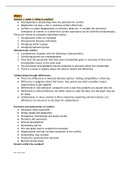College aantekeningen
Conflict Management Summary
- Instelling
- Rijksuniversiteit Groningen (RuG)
This summary includes the notes from the lecture slides as well as the required reading for this course (Textbook: Negotiation by Lewicky, Barry & Saunders).
[Meer zien]





